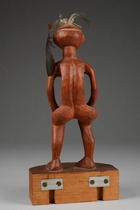Female protective figure "kapinga" · D. R. Congo, Lulua, Artist Kabongo Mai-Mai · ID: 3048025
Emmanuel Ameloot, Ghent, Belgium
Zemanek-Münster, 7 September 2013, Lot 373
Description
wood, feathers, glass, base
Near the end of Belgium’s colonial rule, administrators like Robert Verly, were instigated to find the last surviving sculptors and set up ateliers to preserve and pass on their craftsmanship as well as traditional art forms.
For many carvers in the Congo region had stopped carving traditional masks and figures and instead created works that were suitable for the external market.
Verly’s first “social workshop for indigenous art” was founded in 1955 in Tshikapa. In the following years Verly would open about 20 more of them in the Kasaï region.
This figure can be seen in a 1956 photograph of Verly in the Kaluesha workshop in the Tshikapa region.
Verly wanted to protect the Congolese sculptors from Western influences, but also strove for the further development of indigenous art styles. The extent to which the Belgian administrative officials then again influenced the artistic products of these workshops would have to be investigated more closely.
The object Female protective figure “kapinga” with the object ID 3048025 was last part of the auction 96th Auction at April 24, 2021 on Zemanek-Münster Auction house. The object with the lot number 322 achieved a sales price of EUR 1,500.
You can find more Figures and other popular object types on our related topic pages. You may also be interested in our page on African art.
Comparing literature
http://brunoclaessens.com/2016/02/robert-verlys-influence-on-the-art-of-the-kasai-d-r-congo/#.YEKAvtwxmUk
Publications
Verly, Robert, "L'art africain et son devenir", in: Problèmes d'Afrique Centrale, Numéro consacré à l'art nègre, Brussels: I.N.U.T.O.M.,13e année, 2e trimestre, no.44, 1959:151, # IV-44
AHDRC: 0035408






